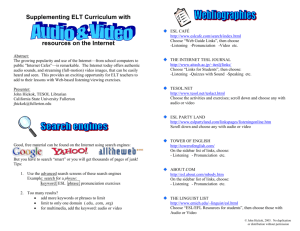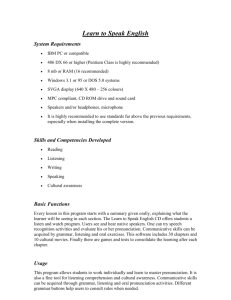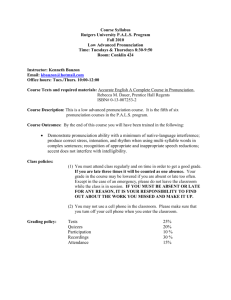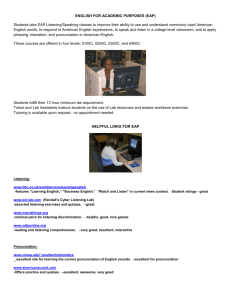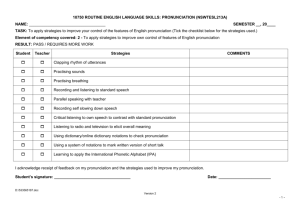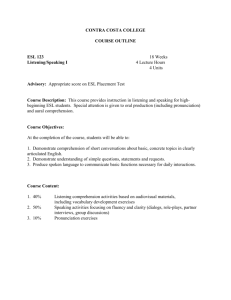Please credit Sue Ingels (The Matrix lesson) and Amanda Huensch
advertisement
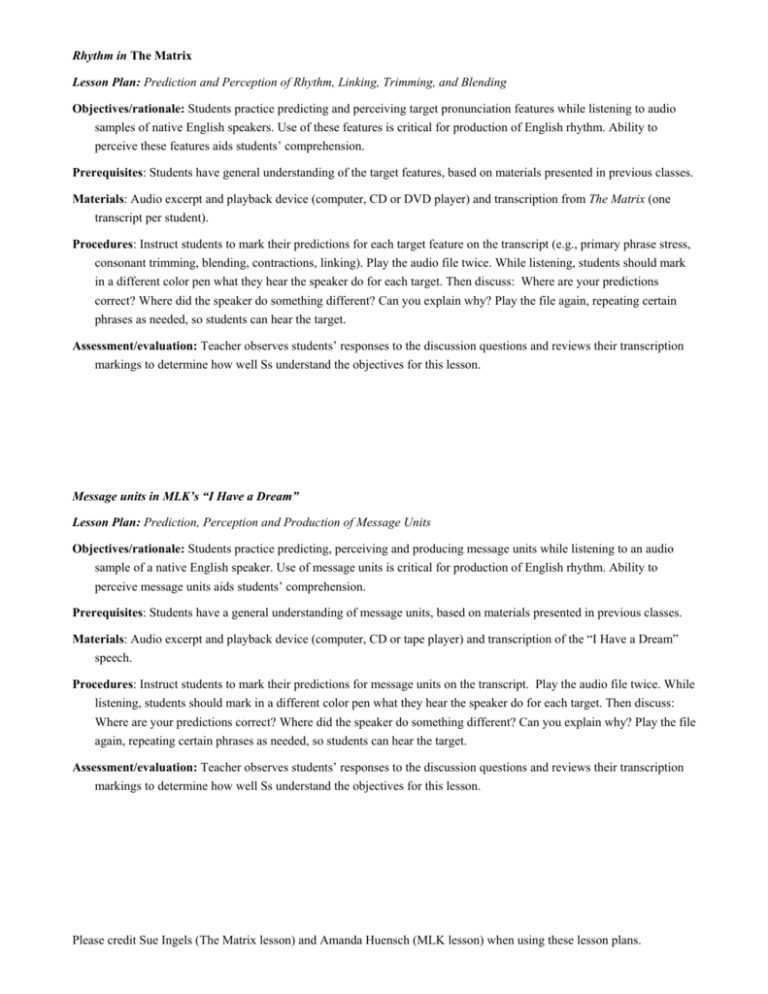
Rhythm in The Matrix Lesson Plan: Prediction and Perception of Rhythm, Linking, Trimming, and Blending Objectives/rationale: Students practice predicting and perceiving target pronunciation features while listening to audio samples of native English speakers. Use of these features is critical for production of English rhythm. Ability to perceive these features aids students’ comprehension. Prerequisites: Students have general understanding of the target features, based on materials presented in previous classes. Materials: Audio excerpt and playback device (computer, CD or DVD player) and transcription from The Matrix (one transcript per student). Procedures: Instruct students to mark their predictions for each target feature on the transcript (e.g., primary phrase stress, consonant trimming, blending, contractions, linking). Play the audio file twice. While listening, students should mark in a different color pen what they hear the speaker do for each target. Then discuss: Where are your predictions correct? Where did the speaker do something different? Can you explain why? Play the file again, repeating certain phrases as needed, so students can hear the target. Assessment/evaluation: Teacher observes students’ responses to the discussion questions and reviews their transcription markings to determine how well Ss understand the objectives for this lesson. Message units in MLK’s “I Have a Dream” Lesson Plan: Prediction, Perception and Production of Message Units Objectives/rationale: Students practice predicting, perceiving and producing message units while listening to an audio sample of a native English speaker. Use of message units is critical for production of English rhythm. Ability to perceive message units aids students’ comprehension. Prerequisites: Students have a general understanding of message units, based on materials presented in previous classes. Materials: Audio excerpt and playback device (computer, CD or tape player) and transcription of the “I Have a Dream” speech. Procedures: Instruct students to mark their predictions for message units on the transcript. Play the audio file twice. While listening, students should mark in a different color pen what they hear the speaker do for each target. Then discuss: Where are your predictions correct? Where did the speaker do something different? Can you explain why? Play the file again, repeating certain phrases as needed, so students can hear the target. Assessment/evaluation: Teacher observes students’ responses to the discussion questions and reviews their transcription markings to determine how well Ss understand the objectives for this lesson. Please credit Sue Ingels (The Matrix lesson) and Amanda Huensch (MLK lesson) when using these lesson plans. Teaching Perception of Suprasegmentals Using Popular Media TESOL 2007, Seattle, WA Sue Ingels Amanda Huensch suemauck@uiuc.edu, University of Illinois at Urbana-Champaign huensch@uiuc.edu, University of Illinois at Urbana-Champaign I. Purpose of presentation II. Definition of suprasegmentals III. Our motivation IV. Brief explanation of 3Ps? V. Criteria for selecting internet materials VI. Demonstration of activities • Rhythm in The Matrix • Message units in MLK’s “I have a dream” • Student-developed materials to encourage self-directed learning Web-Based Resources for English Pronunciation Practice English Club http://pronunciation.englishclub.com/index.htm This website has information on phrase stress, word stress, linking, -ed endings, and more. The focus is primarily on word-level and phrase-level pronunciation, rather than on sound-level. ESL Pronunciation Work Page (University of Florida) http://www.e-pron.com/ Materials to practice word and phrase stress, intonation, sounds; includes audio TESL Journal's ESL: Pronunciation http://iteslj.org/links/ESL/Pronunciation/ Many links to pronunciation exercises. BBC Learning English (news) www.bbc.co.uk./worldservice/learningenglish Bill Hammack’s Engineering & Life http://www.engineerguy.com/ (audio and transcriptions of 2- to 3-minute radio programs on the engineering involved in everyday things, from pop-can top design to contact lenses to ultrasound imaging) Voice of America http://www.voanews.com/english/portal.cfm Listen to broadcasts; transcripts are also available on-line, so you can read and listen. Variety of listening sites, such as National Public Radio, Pulse of the Planet, etc. http://www.iei.uiuc.edu/pron/#listening http://a4esl.org/podcasts/ Podcasts of news, essays, and grammar/vocabulary content; includes transcription of podcast content Search for “ESL podcasts” to find many internet sites with useful content. Many include transcripts. iTunes is another excellent source for many free podcasts. Source for The Matrix: http://www.ompersonal.com.ar/ommovies2/TheMatrix.htm Source for “I Have a Dream”: http://www.americanrhetoric.com/speeches/mlkihaveadream.htm Please credit Sue Ingels (The Matrix lesson) and Amanda Huensch (MLK lesson) when using these lesson plans.
